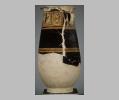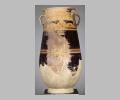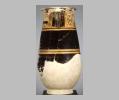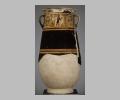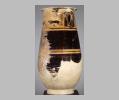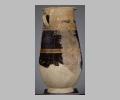| Collection: | University Museum, University of Pennsylvania |
| Summary: | Side A: standing man between geometric panels. Side B: antithetical bulls between geometric panels. |
| Ware: | East Greek |
| Context: | Excavated at Memphis |
| Date: | ca. 575 BC - ca. 550 BC |
| Dimensions: | Pres. H. 0.395 m., D. rim 0.214 m. |
| Primary Citation: | |
| Shape: | Situla |
| Region: | Egypt |
| Period: | Archaic |
Condition:
Side B has lost most of its paint in the center, but the rest of the situla is in fairly good condition.
Decoration Description:
Handle zone, side A: standing man between geometric panels. An unbearded man stands facing right holding a spear or staff in his right hand and an unguent jar(?) in his left. He has long hair and wears a knee-length tunic with a diagonal hem. The shoulders and the hem of his garment have wide decorative borders. There are fan-shaped motifs in the lower right corner and the upper left corner of this narrow panel. The vertical bands to either side are decorated with rosette-filled squares. The panels next to the handles contain elaborate rosettes with crosses painted over them.
Side B: antithetical bulls between geometric panels. Much of the paint on this side has been lost, but the two bulls can be clearly seen in their outlines. Their heavy head and horns are almost touching as they stand facing one another. Rosettes fill the field and there are larger motifs under the bellies of the bulls. The vertical bands framing the rectangular panel with the bulls are decorated with cross-filled squares.
The body of the vase is divided into large black zones by reserved bands decorated with narrow stripes.
Shape Description:
Schaus believes the reconstructed lower wall is too elongated.
Collection History:
The situla was recovered in excavations at Memphis (Mt-Rahneh) led by Eckley B. Coxe, Jr. in 1918. It was said to have come from some of Petrie's debris from holes south of the house on the site.
Sources Used:
Other Bibliography:
